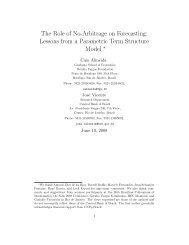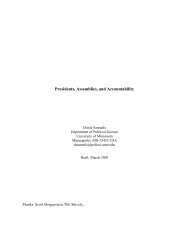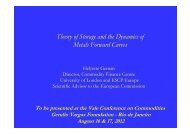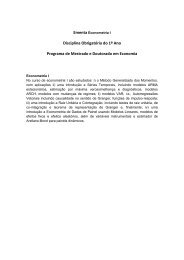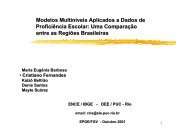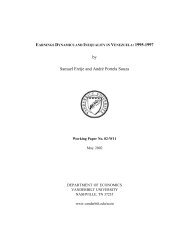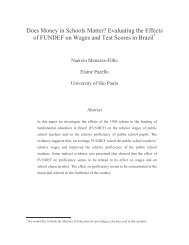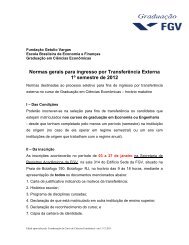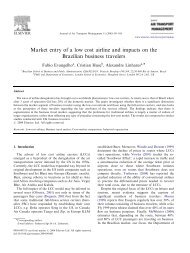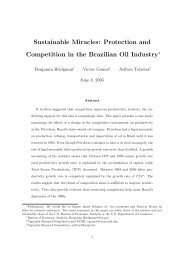Estimations of generic drug entry in Brazil using count ... - EPGE/FGV
Estimations of generic drug entry in Brazil using count ... - EPGE/FGV
Estimations of generic drug entry in Brazil using count ... - EPGE/FGV
Create successful ePaper yourself
Turn your PDF publications into a flip-book with our unique Google optimized e-Paper software.
<strong>of</strong> entrants followed a b<strong>in</strong>omial distribution, approximated by a Poisson distribution,yield<strong>in</strong>g <strong>in</strong> turn a hazard rate regression; an iterative procedure was undertaken to ac<strong>count</strong>for the endogeneity <strong>of</strong> the (unobserved) rent variable present <strong>in</strong> the three equations. Thepost-patent-expiration price when there are i <strong>generic</strong> <strong>drug</strong>s <strong>of</strong> type k, relative to the price<strong>of</strong> the pre-<strong>entry</strong> branded version <strong>of</strong> the same <strong>drug</strong> was regressed on cost and demandshifters and on dummies for each possible number <strong>of</strong> <strong>generic</strong>s. The total log-revenue<strong>of</strong> the <strong>generic</strong> <strong>drug</strong>s was then regressed on the average pre-patent-expiration brandedversion revenue and on other expla<strong>in</strong><strong>in</strong>g variables (some <strong>of</strong> them present <strong>in</strong> the previousregression equation). The results <strong>in</strong>dicate that the ‡ow <strong>of</strong> <strong>generic</strong> <strong>in</strong>dustry rents <strong>in</strong> theUSA <strong>in</strong>creases for the <strong>in</strong>itial 5 to 10 months follow<strong>in</strong>g patent expiration but then fallsas more entrants compete away price-cost marg<strong>in</strong>s. For markets <strong>of</strong> su¢ cient size <strong>entry</strong>will ultimately lead to near-competitive levels, while prices rema<strong>in</strong> above marg<strong>in</strong>al cost<strong>in</strong> small markets without <strong>in</strong>duc<strong>in</strong>g <strong>entry</strong>. The authors used a data set cover<strong>in</strong>g 31 <strong>drug</strong>sthat went o¤ patent <strong>in</strong> the late 1980s and early 1990s <strong>in</strong> the USA.Bae[1] used a proportional hazard regression model to estimate time <strong>of</strong> delay (<strong>in</strong> days)to <strong>entry</strong> after patent expiration <strong>in</strong> the USA for a list <strong>of</strong> 77 s<strong>in</strong>gle-API <strong>drug</strong>s that lostpatent dur<strong>in</strong>g the period 1987-1994. Aga<strong>in</strong>, <strong>entry</strong> is faster <strong>in</strong> markets <strong>of</strong> greater revenue,with fewer branded competitors, and for chronic-use <strong>drug</strong>s. The Medicaid Drug RebateProgram, which imposed mandatory rebates o¤ the private sector wholesale prices for theMedicaid (public) purchases, had a positive impact on the <strong>entry</strong> delay.Hudson[10] studied <strong>entry</strong> <strong>in</strong> four developed <strong>count</strong>ries: USA, UK, Germany and Japan.USA and Japan are the greatest pharmaceutical markets <strong>in</strong> the world, as measured byrevenues. He analyzed: (i) the determ<strong>in</strong>ants <strong>of</strong> <strong>generic</strong> <strong>drug</strong> <strong>entry</strong>; (ii) determ<strong>in</strong>ants <strong>of</strong><strong>entry</strong> delay when <strong>entry</strong> does occur; (iii) impact <strong>of</strong> <strong>entry</strong> on the orig<strong>in</strong>al brand’s sales. Hisresults also suggest that the greater the market, the more likely are <strong>entry</strong> and its impacton the orig<strong>in</strong>al <strong>drug</strong>’s sales. His estimations are based on a sample <strong>of</strong> the …fty best-sell<strong>in</strong>gAPIs present <strong>in</strong> at leas one <strong>of</strong> these <strong>count</strong>ries.Rudholm [23] analyzed determ<strong>in</strong>ants <strong>of</strong> <strong>generic</strong> <strong>entry</strong> <strong>in</strong> Sweden, where a referencepric<strong>in</strong>g system has been used for reimbursement purposes s<strong>in</strong>ce 1993. Unfortunately hisdata (a panel <strong>of</strong> twenty-two APIs from 1972 to 1996) have a short overlap with the periodafter the <strong>in</strong>troduction <strong>of</strong> this system. He ran an <strong>in</strong>teger-valued autoregressive model byNon-L<strong>in</strong>ear Least Squares, and found that expected pro…ts a¤ect positively the number10




